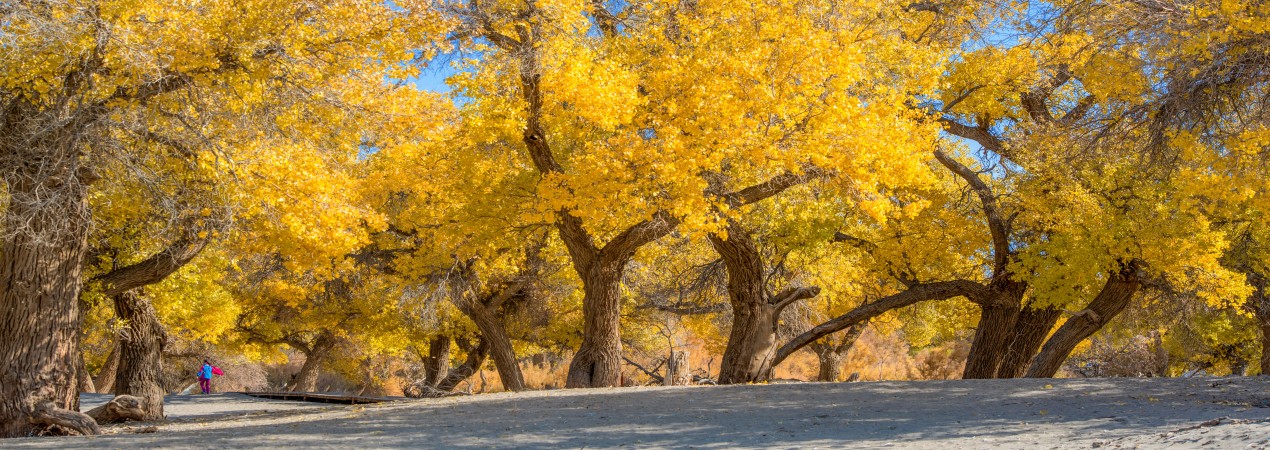Tarim Poplar Forest National Forest Park

Tarim Poplar Forest National Forest Park is located in the middle reaches of the Tarim River, on the northeastern edge of the Taklimakan Desert, about 70 kilometers south of Luntai County along the Desert Highway in Bayingolin Mongol Autonomous Prefecture. It is the largest primitive poplar forest park in Xinjiang, covering a total area of 100 square kilometers. Integrating the natural landscape of the Tarim River, poplar landscapes, desert landscapes, and petroleum industry landscapes, it serves as a natural scenic tourist resort for sightseeing, leisure and entertainment, field exploration, and popular science research.
- Chinese name: 塔里木胡杨林国家森林公园 Tǎ lǐ mù Hú yáng lín Guó jiā Sēn lín Gōng yuán
- Suggested time: 3 - 4 hours
- Ticket: 45 yuan per person. Additionally, there are fees for internal transportation.
- Open hours: 09:00 - 20:00. Note that during the peak viewing season of autumn foliage, the opening hours may be adjusted according to the actual situation, it's better to check in advance.
- The best time to visit: From late September to early November
- Address: Along the Tarim Desert Highway, about 70 kilometers south of Luntai County, Bayingolin Mongol Autonomous Prefecture, Xinjiang Uygur Autonomous Region, China
- How to get there: It is recommended to charter a car or join a tour group.
Highlights of Tarim Poplar Forest National Forest Park
Poplar Forests
 Poplar Forests
Poplar ForestsTarim Poplar Forest National Forest Park is the largest primitive poplar forest park in Xinjiang and the most concentrated area of primitive poplar forests in the entire Tarim River basin.
At the entrance of the park, you can see the "Poplar King". It is one of the oldest poplar trees in the park, with a tree age of about 3,200 years. Its trunk is thick and sturdy, its branches are luxuriant with dense leaves, and it towers high into the sky, just like a guardian. It is a representative of the vigorous vitality of poplars and also embodies the indomitable poplar spirit.
Near Qiayang River Station, there is an observation deck over 20 meters high, from which you can overlook the endless golden poplar forests in autumn. Alternatively, you can take a retro sightseeing train. The train passes through the poplar forests, passing by tamarisk clusters, reed marshes, the Qiayang River and lakes in the forest. Traversing the golden poplar forests in the golden autumn season is listed as one of the best photography scenes.
Educational Value
The scientific educational significance of Tarim Poplar Forest National Forest Park is profound and diverse. As a typical example of arid zone ecosystems, it provides a natural classroom for botanical research. Poplars have the characteristics of longevity, drought resistance, salt-alkali tolerance and tough wood, which can intuitively demonstrate the adaptive evolution of plants to extremely arid and salt-alkali environments. Their special physiological mechanisms (such as salt secretion and water absorption through deep root systems) are vivid cases for understanding the co-evolution of organisms and the environment.
Activities to do at Tarim Poplar Forest National Forest Park
Sightseeing and photography: Late autumn is the best time. You can walk along the wooden plank road into the depths of the poplar forest and take photos of the magnificent scenery where the golden poplars and the Tarim River reflect each other.
Taking the small train tour: Take the 13-kilometer circular sightseeing train in the scenic area, which threads through the poplar forests and lakes, allowing you to easily visit multiple core attractions. You can stop at any time along the way to enjoy the view and take photos, making it suitable for casual sightseeing.
Popular science research and study: Visit the popular science signboards and exhibition areas in the scenic area to learn about the growth habits of poplars and knowledge about arid zone ecosystems; or study scientific content such as the stress resistance of poplars and ecological protection of the Tarim River basin.
Drop us a line and we'll connect you with the top China expert in no time!